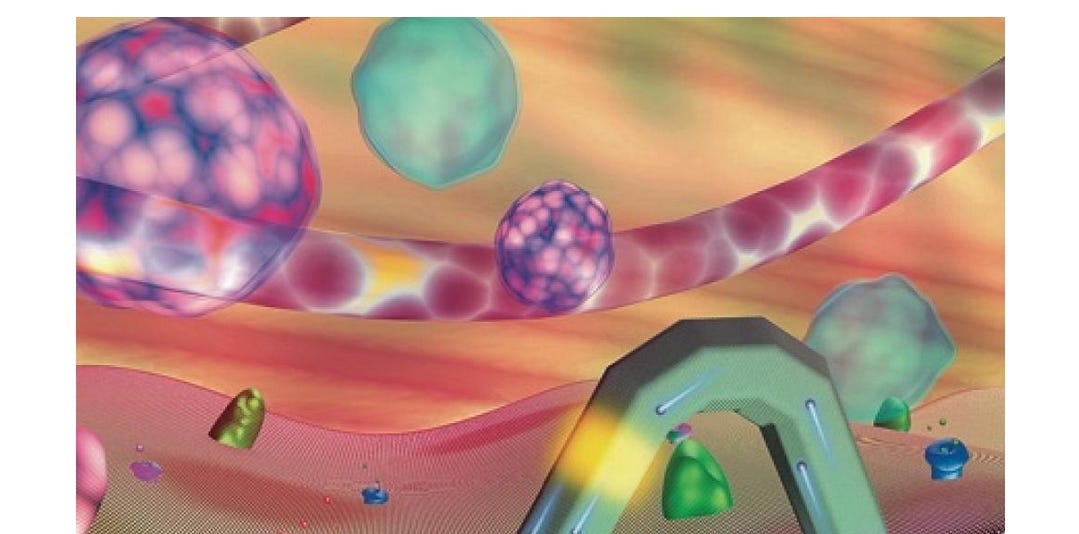Right Now | Man and Machine Virus-Sized Transistors by Jonathan Shaw
Turning man into machine
Imagine being able to signal an immune cell to generate antibodies that would fight bacteria or even cancer. That fictional possibility is now a step closer to reality with the development of a bio-compatible transistor the size of a virus. Hyman professor of chemistry Charles Lieber and his colleagues used nanowires to create a transistor so small that it can be used to enter and probe cells without disrupting the intracellular machinery. These nanoscale semiconductor switches could even be used to enable two-way communication with individual cells.
Lieber has worked for the past decade on the design and synthesis of nanoscale parts that will enable him to build tiny electronic devices (see “Liquid Computing,” November-December 2001, page 20). Devising a biological interface, in which a nanoscale device can actually communicate with a living organism, has been an explicit goal from the beginning, but has proven tricky. At its simplest, the problem was inserting a transistor constructed on a flat plane (think of the surface of a computer chip) into a three-dimensional object: a cell perhaps 10 microns in size. Merely piercing the cell was not enough, because transistors need a source wire from which electrons flow and a drain wire through which they are discharged.
The key, Lieber says, was figuring out how to introduce two 120-degree bends into a linear wire in order to create a “V” or hairpin configuration, with the transistor near the tip. Getting the entire structure off the surface on which it had been created was easier: Lieber integrated the nano-wire probes with a pair of bimetal, layered interconnects. Joined strips of two different metals that expand at different rates have been used in thermostats for years--when the temperature changes, one metal swells or contracts more than the other, bending the thermostat to the opposite side to accommodate the expansion. Lieber used this principle to lift the transistor up and out of the flat plane on which it was created.
When he finally engineered the tiny device and tried to insert it into a cell, however, he had no luck: pressing hard enough to disrupt the cell membrane, he reports, killed the cell “pretty quickly.” But when his team coated the hairpin nanowire with a fatty lipid layer (the same substance cell membranes are made of), the device was easily pulled into the cell via membrane fusion, a process related to the one cells use to engulf viruses and bacteria. This innovation is important, Lieber explains, because it indicates that when a man-made structure is as small as a virus or bacteria, it can behave the way biological structures do.
Tests of the device indicate that it could be used not only to measure activity within neurons, heart cells, and muscle fibers, for example, but also to measure two distinct signals within a single cell simultaneously--perhaps even the workings of intracellular organelles, the functional units within cells that generate energy, fold proteins, process sugars, and perform other critical functions. (When those processes stop working, the breakdown can lead to diseases such as diabetes, heart disease, or Tay-Sachs.) And because a transistor also allows the application of a voltage pulse, such devices might one day provide hybrid biological-digital computation, or deep-brain stimulation for Parkinson’s patients, or serve as an interface for a prosthetic that requires information processing at the point where it attaches to its owner.
“Digital electronics are so powerful that they dominate our daily lives,” Lieber points out. “When scaled down, the difference between digital and living systems blurs, so that you have an opportunity to do things that sound like science fiction--things that people have only dreamed about.”





This application of biotechnology in humans sounds so promising... Depending on who's using it and for what purpose. Now... Can scientists do research to clean up our air from other nano sh...., they use in chemtrails instead? is cleaning up our rivers and oceans is too boring? did giving us (back) clean traditionnal real food organically grown ever crossed their minds instead of researching new forms of nano-life that do not belong in our bodies anyways? why those salaries and grants to change/"enhance" humans when we were created with God-given DNA and natural immunity? I'm appalled at the lack of wisdom of world leaders.